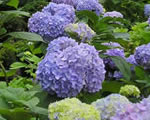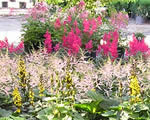
5155
NW 57th Ave
Johnston, Iowa
Click for Directions
Store
Hours
Monday
- Friday
8:00am - 5:00pm
Saturday
8:00am - 4:00pm
Retaining Walls
| Retaining walls are
an integral part of many landscapes. Miller Nursery's landscape
designer, Craig Westfield, is our resident expert on designing retaining
walls. This article will pick his brain about the different types
of walls available to our customers. So, why build a wall? Most walls are built for slope management and drainage control. Many homes require a retaining wall around the foundation to create a level planting surface. But walls can also be built for aesthetic purposes. An island or berm can be a wonderful perennial garden and add great value to the landscape. Other important factors are strength, longevity, and functionality. What kind of wall is necessary to control drainage? How high does the wall need to be? How many years should the wall last? These are just a few of the basic questions that must be answered before beginning construction. There are a number of factors when choosing what kind of material. Aesthetics is the first consideration. It is very important to match the material with the house. For example, a 1000 pound boulder is going to look funny as part of a wall next to a two bedroom house. This is an extreme, but it is essential to match the materials to the building. Furthermore, each homeowner has a different opinion of what they want. And that is probably the most important consideration, the customer must feel comfortable with the material selection. Then there is the burning question, how much does it cost? It is always important to plan a landscape with a budget in mind. A wall can become very expensive and cut into other parts of the landscape. The three types of materials used by Miller Nursery for residential landscapes are timbers, segmental units, and natural stone. So with this said, let's explore the different materials available for retaining walls. The first material available for retaining walls are timbers. They are usually made from pine trees, but other woods can be used. The wood is treated to resist the elements and prevent rotting. Timbers are probably the least expensive option for retaining walls, but they have issues with longevity. The average timber wall will last anywhere between 10 to 20 years. This will differ greatly based on how the wall is exposed to the elements. Timbers can split over time. Sometimes a split is undetectable during construction but can become worse as the wall grows older. Another disadvantage of timbers is the inability to create a curve. Obviously, a timber will not bend, so any change in direction must be created with an angle cut. However, timbers do have a very natural feel as they blend into the landscape very easily. Another material available for retaining walls are segmental units. These are also known as pre fabricated concrete units. Craig uses Rockwood brand retaining wall units for all of the segmental walls built by the Nursery. He feels Rockwood offers the best locking system, has the most effective drainage system, and is the easiest to install. Rockwood offers the units in three sizes. Four inch, six inch, and eight inch units are available. Each block has a lip on the bottom of the block that provides a setback and acts as a locking system. This allows the wall to step back into the hill naturally and uniformly. The first unit in the wall is placed on a layer of crushed rock. As more layers are added, crushed rock is placed between the blocks. This creates better stability for the wall and also prevents water or dirt from seeping through the wall. The very top layer of the wall is made of cap units. This is a solid unit that creates a smooth top layer and gives the wall a finished look. With proper construction and reinforcements, a wall can be built to forty feet in height. Also, Rockwood offers the units in gray, brown, sandstone, hunter tan, and charcoal. There are some drawbacks to segmental units. They can be overpowering in a landscape and put too much focus on the wall. To prevent this, it is very important to choose a color that matches or contrasts naturally to the color scheme of the house. There are also complaints that segmental units have a cold feeling. This can be true, but Craig feels strongly this can be eliminated with the right color. A natural feel can also be obtained with landscape boulders or limestone. Craig is not a big fan of natural stone in a residential setting for a number of reasons. His main point of contention is the cost. In the past six years limestone has doubled in price. There has been a huge demand from the commercial landscape industry which tightens the supply and makes it unreasonable for many residential customers. The labor to install a retaining wall with natural products is also quite high compared to other materials because every piece of stone is different. It is very time consuming to piece together boulders or limestone. However, if the customer is willing to accept the cost, natural stone adds an extra touch to the landscape. There is no way of reinforcing natural stone which can make the wall unstable in the long run. It is impossible to reach the heights of the segmental units with a natural material. Boulders and limestone also do not have the pressure ratings of segmental units. Rockwood's product has a compression strength of at least 4000 PSI. Limestone has a much lower PSI. So what are the conclusions? Craig is a firm believer in segmental wall units. He says it is by far the leader in strength, longevity, and aesthetics. This comes from over ten years of experience with all three materials. However, Craig says the final decision is ultimately up to the customer as to the type of material they would prefer in their landscape. |
© Miller Nursery Inc. 2008


